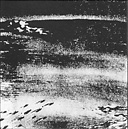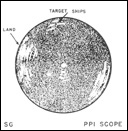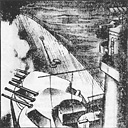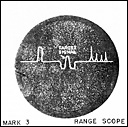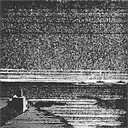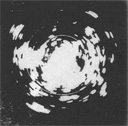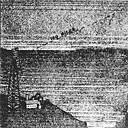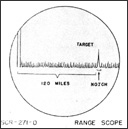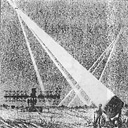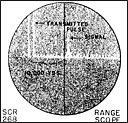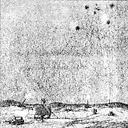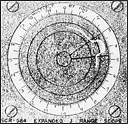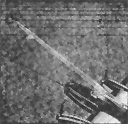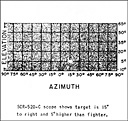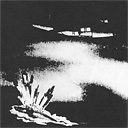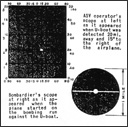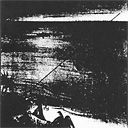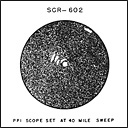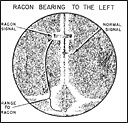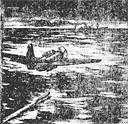
What Is Radar?
-
RADAR -- synthetic word meaning Radio Direction
And Ranging -- is an electronic device which locates
ships and planes in darkness, fog, or storm. It has
many military applications and has been effective in
many battles of this war.
-
As early as September, 1940, radar enabled British
fighters to bring down 232 enemy planes in one day
with a loss to themselves of only 40 planes and 12 pilots.
-
Later, in 1942, radar enabled an American cruiser
to surprise a formation of Japanese warships at night
and sink 6 of them in total darkness.
-
Again in the Pacific radar warned one of our
carriers of enemy planes approaching at 70 miles.
Fighters went up and shot down 18 planes out of 20.
-
In North Africa, one radar ground station working
with a squadron and a half of radar-equipped night-fighters
shot down 29 enemy bombers and damaged two
others in one month's operation.
--1--
--How Radar Works--
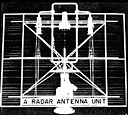 SOME RADAR SETS have separate antennas for
sending and receiving, but the commonest
form uses one unit in both functions.
SOME RADAR SETS have separate antennas for
sending and receiving, but the commonest
form uses one unit in both functions.
 RADAR WORKS in "complete cycles". Time
is allowed for an echo from one pulse to
be received before another is sent out.
RADAR WORKS in "complete cycles". Time
is allowed for an echo from one pulse to
be received before another is sent out.
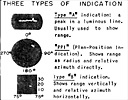
Three Types of Indication
|
The principle upon which radar operates
is simple. Briefly, it consists of sending
out a short pulse of radio energy and receiving
a portion of the same energy reflected
back by objects in its path.
The energy sent out by a radar set is
the same as that transmitted by ordinary
radio. But unlike an ordinary radio set
a radar set literally picks up its own
signals. Thus the radar set transmits a
short pulse of energy, receives its echoes,
then transmits another pulse and receives
its echoes. This out-and-back cycle is repeated
from 60 to 5000 times a second.
The extremely short time interval between
the sending of the pulse and the reception
of its echoes can be measured very
accurately--even to one ten-millionth of
a second. Since the speed at which the
radio energy travels is known (it is the
same as that of light) the range of any
reflecting object can be obtained.
Furthermore, the transmitted energy is
focussed in a beam which can be pointed in
any chosen direction. Hence the bearing
of a reflecting object is also obtained.
The echoes received by the radar appear
not as sound signals, as is the case with
ordinary radio, but as marks of light on
a flourescent tube. The face of the tube--or
scope, as it is usually called-may be
marked with a scale of miles, or degrees,
or both. Hence from the position of any
signal on the scope an observer can tell
at a glance the range and direction of the
corresponding target. The three commonest
types of scopes are shown in the sketch at
the left.
Just as there are different types of
scopes, there are many kinds of radar
sets. They vary in size from those that
can be carried by hand to those that weigh
several thousand pounds. The design of a
radar set depends upon the job it is intended
to do, and radar serves many functions.
The chief of these are described
in the following pages.
|
--2--
What Radar Can Do
ACTUAL-SIZE PHOTOGRAPH of a radar "scope," taken in a
plane flying over Nantucket Island. Circle on scope
marks 10-mile radius. Note correspondence with
geodetic chart (insert.)
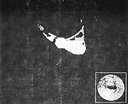
THIS PHOTOGRAPH ILLUSTRATES the clear
definition between land and water provided
by radar, as well as the sort of picture
presented on one type of radar scope.
Such definition, of course, is useful as
an aid in navigation of planes and ships,
in observing the movements of ships and
convoys, in detecting targets at night,
in shelling or bombing enemy vessels or
coastal targets, or in mapping work.
This PPI scope has a flourescent screen
so made that the signals from reflecting
objects will persist for a few moments.
Other types of scopes are shown on the
following pages, illustrating some of the
chief uses of radar. For most of these
functions, several radar sets are now
available. Details of design, operation
and performance of specific sets are
listed later in the book.
--3--
Radar Aids Ships in Locating Planes & Surface Craft
RADAR ENABLES ships to detect planes out
to 100 miles and surface vessels to 28,000 yds, and to distinguish between friendly
and enemy craft. It can be used to locate
enemy units in night battles, to
maintain convoy formation and to navigate.
Radar Controls Ship Gunfire
AFTER LOCATING SHIPS, radar provides
range and bearing of targets to the guns,
and permit the course of the enemy ship
to be calculated more accurately than by
any other method. Accurate and continuous
determination of range rate allows the
gunnery officer to alter fire to take into
account the enemy ship's change in course.
--4--
Radar Defends Coastlines Against Ships
SHORE-BASED SETS can maintain a round-the-clock
seaward search, detecting ships as
far out as 45 miles. These sets can direct patrol craft to unidentified ships,
can guide friendly ships through mine
fields or fog, and can assign any targets
to other radars having the specific function
of coast artillery gun-laying.
Radar Gives Long-Range Warning of Planes
RADAR CAN DETECT high-flying planes as far
away as 135 miles, and permit plotting of
their location, approximate course and
speed. Enough warning is given to allow
fighter planes to take off, thus eliminating
the need for a standing air patrol.
--5--
Radar Can Direct Searchlights
RADAR GIVES SEARCHLIGHT crews a 40,000-yd. warning and sufficient
data so that planes
will be struck instantly at
least 90% of the time when
the lights are turned on --
thus preventing planes from
evading the beams.
Radar Directs Anti-Aircraft Fire
MOBILE RADAR provides range for
anti-aircraft guns, day or
night, more accurately than
optical height finders, and
can give continuously and
automatically the elevation
and azimuth of target regardless
of its visibility.
--6--
Radar On Ground Directs Nightfighters

RADAR ENABLES a control officer at a
fighter base to keep track of enemy planes and his own fighters within a range of 45
miles, and to direct fighters by voice to within 2 miles of enemy planes.
From this range the fighter can, in daytime, complete the interception visually,
or at night, the fighter can track the target to gun range by means of another
radar set (AI) carried in his own plane.
Radar In Plane Leads Fighters To Gun Range
A NIGHTFIGHTER can detect an enemy plane
by radar when the plane is 7 miles away, and reliability is certain at 4 miles. A
CGI should direct a nightfighter to within 20,000 feet of the target, at which point
the nightfighter's radar (AI) will permit tracking until the enemy plane is within
firing range.
--7--
Radar Enables Planes To Detect and Bomb Ships
A RADAR-EQUIPPED PLANE can do blind bombing
with the aid of a Norden bombsight attachment that is more accurate at low
levels than a Norden bombsight itself in visual day bombing. At 5000 feet a plane
with SCR-517 can detect a 10,000-ton ship 45 mi. away, a surfaced sub at 18 miles --
hence, can patrol sea lanes, shepherd convoys, and do reconnaissance in fleet operations
regardless of night or bad weather.
Radar Guards Beachheads and Advanced Bases
LIGHT-WEIGHT RADAR SETS may be used in
warning a beachhead or advanced base of approaching enemy planes or ships (at
night for example), or in directing beachhead operations from the first point of
debarkation when landing barges have radar navigation eqauipment. A key for sending
messages can be used with portable sets.
--8--
Radar Aids Navigation of Planes & Ships
ONE RADAR DEVICE is a beacon (Racon) that
emits coded signals in response to radiation from a plane or ship, keeping silent
when not actually in use, and able to guide planes to a base or carrier 80 miles
distant. Another device (Loran) enables ships to find their position to within 1
mile, as far as 1250 miles from shore.
Beacuse of the clear definition between land and water provided by radar, as is
illustrated in the scope photo of an island on page 3 of this book, important
navigational aid can be given planes or ships at night, in fog or storm; e.g., in
guiding planes to an island or coastal target.
PLANE AT LEFT is at 30 feet. Low-level
altimeters measure from 400 to 5 feet. Other radar altimeters can measure absolute
altitue as high as 40,000 feet.
--9--
Limitations of Radar
As has been seen on the previous pages, radar can be useful
in almost any military situation. But the successful
use of radar demands an understanding of its properties.
Radar has several inherent limitations: it cannot "see"
under water, for example, nor very far beyond the line of
sight. Its range is affected to some extent by atmospheric
conditions. Radar sometimes records signals from clouds,
which to an inexperienced operator resemble signals from
aircraft or ships. It is still a new weapon, rushed through
production and into field use in so short a time that frequent
instances of faulty operation and breakdown are encountered.
Further, the performance and operation of individual radar
sets vary greatly. The most important factors in the performance
of a set are the wavelength used and the proficiency
of the operating and maintenance crews; in the set
descriptions which follow the range of wavelength is indicated.
Sets in the shortest wavelength range are called microwave.
those in the intermediate wavelength range are referred to
as medium wave. Those employing the longest radar wavelengths
(which are still shorter than the waves used by high-frequency
radio communications) are designated long wave.
Most radar equipment now issued uses a long or medium wavelength.
Sets employing these frequency ranges usually have
a long range, which increases with the size of the antenna
and the height at which it is mounted. The definition and
angular accuracy, however, are poor. Choice of a location
for these sets is most important, since the presence of
hills, buildings, or other reflecting objects within view of
the radar site will cause permanent echoes on the scope.
Long wave ground or ship sets, too, give poor protection
against distant surface vessels of low-flying planes.
Usually, there are also gaps in the coverage against aircraft
within the extreme detection range.
Microwave equipment has the advantage of sharper definition
and greater angular accuracy. It also offers better coverage
of objects at low elevation angles, and is less dependent
upon careful choice of site. Most microwave sets now in
production do not have as great a range against high-flying
aircraft as that of long wave equipment. Gaps in coverage
are less important in microwave sets, but there is likely to
be poorer coverage against high-altitude planes.
The ability of radar to "see" under any conditions of visibility
and to give continuous accurate values of target
range and direction has considerably altered the military
picture; but the full capabilities of this new facility can
be realized only when all concerned appreciate its possibilities
and requirements.
--10--
Radar in Planning
First, the commanding officer and his staff must have
such an appreciation. They must understand that radar
permits undertakings of a wholly new type to be carried
out. For example, ships can be navigated at night at high
speed in narrow waters with precision and safety, and can
engage an unseen enemy with guns or torpedoes. By the use
of radar beacons, aircraft can home with an accuracy
measured in yards on an objective distant 80 miles or more.
The commanding officer and his staff must appreciate
that the employment of radar by the enemy must always be
assumed, and they must understand what this means in terms
of their plans. Darkness, smoke, or fog must no longer be
relied on for certain cover. Aircraft approaching an objective
must no longer fly as high as possible to escape detection;
better results will attend a very low approach or
one which makes use of the radar "shadows" cast by mountains
obstructing radar beams. The use of countermeasures
to confuse or defeat the enemy's radar must be considered
in planning crucial operations.
It must be understood that radar cover against air attack
must be planned for the very earliest stages of a new
occupation. Only by the timely alerting and the defensive
facilities provided by radar will it be feasible to deal
with the sustained air attack which can be mounted by a determined enemy.
Radar in Tactics
The tactical officer in the field must understand the
power that radar gives him. Its use is so new that tactical
doctrine is still being worked out, and an ingenious officer
will sometimes be able to employ one of the sets described
in the following pages in a military situation never contemplated
by its designer.
For example, there is the case of a patrol bomber
equipped with ASE, which located enemy ships and attacked
them unsuccessfully. A squadron of motor torpedo boats not
equipped with radar was available, and the aircraft was
directed to cruise in the area and direct the PT boats to
the target, using the general situation plot provided by
the radar. The PT boats were thus enabled to make a
successful attack.
--11--
Full reliance must be placed on radar in order that it
may be wholly effective. In the Hood-Bismarck engagement,
for example, the gunnery officer of the Hood had his choice
between using optical and radar range information, which
differed by 4000 yards. For his first salvo, he used the
optical range value. There was no opportunity to fire another.
The Operation of Radar
Finally, the officer in charge of the actual operation of
radar equipment must be resourceful, skillful, and well-informed.
As has been remarked, technical difficulties with
the equipment are all too frequent, and must often be dealt
with without the help of adequate spares or test equipment.
The radar officer must realize that the reliance which will
be placed on the information provided by his equipment will
largely depend on the reliability with which it has been
made available.
He must be prepared at all times for the employment of
countermeasures by the enemy, in an attempt to render our
radar partly or wholly useless. In general, such measures
can be dealt with by an experienced and resourceful radar officer.
He must understand that the proper interpretation of the
signals presented by the radar equipment is most important.
Spurious echoes from clouds must be recognized as such, the
reliability of IFF indications must be maintained to avoid
false alarms, and highly skilled interpretation of signals
will even enable fairly accurate estimates to be made of
the size and character of enemy forces from the radar
signals they present.
Our Radar Equipment
Given this understanding and skillful use of radar by all
concerned, we shall have the advantage of the enemy in this
field. Experts assert that the state of technical development
of U.S. Radar equipment described on the following
pages is about one year in advance of that available to
the enemy. The enemy is doing well with what he has got;
it is only through conscientious and imaginative use that
our better equipment can be made to count.
--12--
Table of Contents *
Next Chapter (Shipborne Search Sets)





